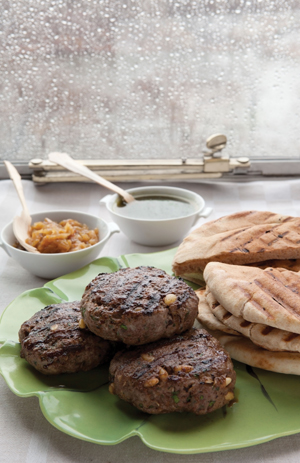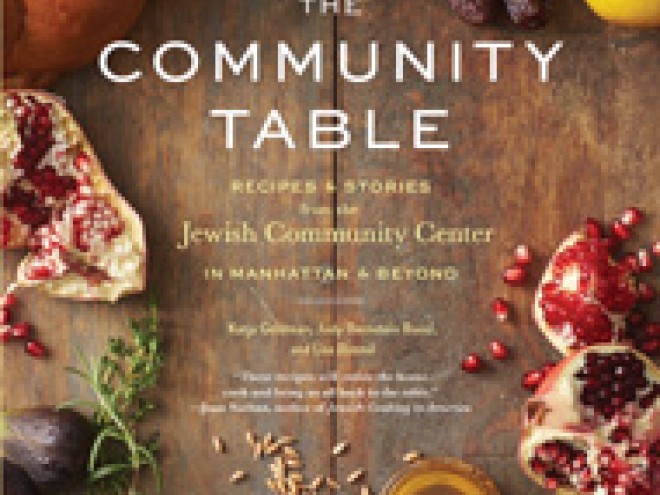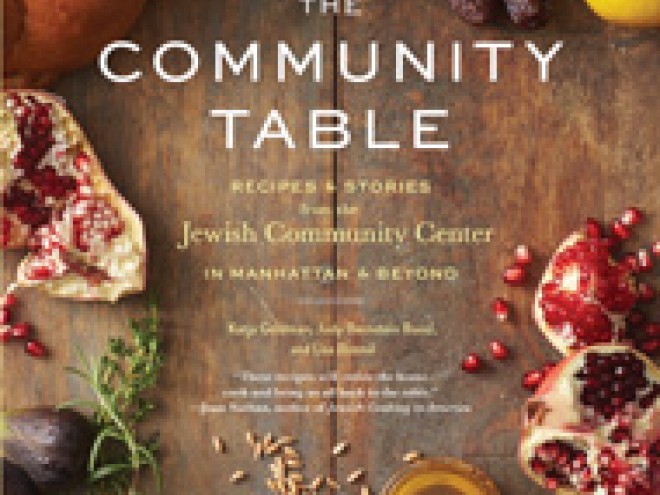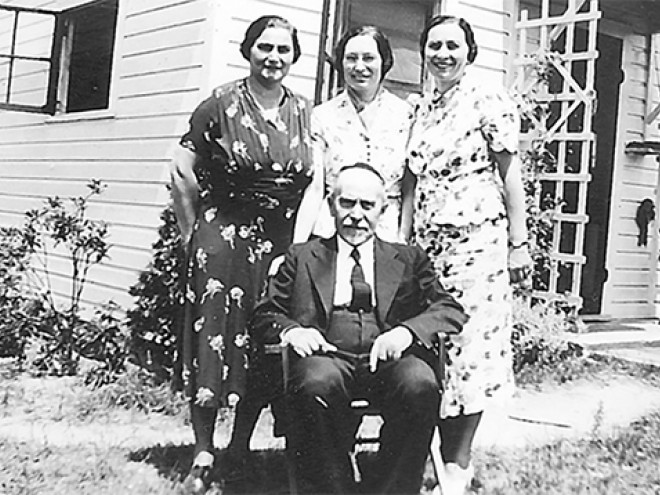Katja Goldman, Judy Bernstein Bunzl, and Lisa Rotmil are the authors of the new cookbook The Community Table: Recipes and Stories from the Jewish Community Center in Manhattan and Beyond. They are blogging here this week for Jewish Book Council’s Visiting Scribe series.
Really? Another cookbook? Another Jewish cookbook? Well, actually yes.
This one started a few years back when JCC Manhattan was approaching a major milestone (a 10 year anniversary). Judy Bernstein Bunzl was the one who first imagined doing a cookbook to celebrate the vision and mission of the JCC Manhattan on this occasion. We had no idea how many years it would take to actually complete the task!
Judy asked Katja Goldman to join her right away because she is Judy’s go-to food and gardening soulmate. Katja then insisted that we needed Lisa Rotmil to complete our team. Thus our book, The Community Table: Recipes and Stories from the Jewish Community Center in Manhattan and Beyond, was born.
Who knew that it would be three years of cooking, tasting, testing again, writing, and then styling every photo shoot? While some might worry that three chefs is too many in the kitchen, for us, it was the perfect number for creativity and culinary inspiration. Indeed, coming from different cooking styles, different kitchens, and different palates, our micro-community was a template for the larger community we were cooking for.
So what did we come up with? Well there is certainly a lot to be inspired by. Jews have been cooking for centuries in lands far and wide. Often what constitutes Jewish cooking is some amalgamation of the resident culture mixed up with Jewish tradition. Think carciofi al guidea, the Roman artichoke dish associated strongly with that Jewish community. Or chicken paprikash from Hungary, served without the sour cream. This book revels in that kind of adaptation. We’ve included recipes from Sri Lanka, an Indian masala, corn bread from Atlanta, and pot-au-feu from Alsace (one of the oldest Jewish communities in Europe). We also wanted to reflect how we cook right now, with an emphasis on grains, vegetables, salads, roasted meats, and fish. Plus we couldn’t leave behind the traditional Jewish classics we grew up with and many that we’ve updated to turn them into something new — adaptations for the twenty-first century in New York City and beyond. There is a lot to sample!
We are asked repeatedly what inspired some of our favorite recipes. We have so many to choose from, but here is a great example of how our Iraqi Lamb Burger came into being:
On a rainy day in New York City, we all yearned for a burger. “Let’s not use beef,” was the starting point. With the three of us coming from Ashkenazi backgrounds, we decided to try something different and draw upon Middle Eastern influences. We also love lamb, so that became the springboard for our thinking. Throw in fresh mint, allspice, pine nuts, cinnamon, and of course Italian parsley, and the result was an unexpectedly delicious harmonious mouthful. And of course we didn’t stop there, because every great burger has its own special condiments. So in our book, we also give you recipes for Mint Pesto and Caramelized Saffron Onions.
As we were writing the book, we all realized how much we love it when recipes discuss variations of the base recipe. Don’t like lamb? Substitute beef. Craving a grandma’s stuffed cabbage? Use the meat mixture and just wrap it up in cabbage leaves. And we tried to do the same thing. Directions found in our book.
Some may ask: what do the main values of JCC Manhattan — diversity and inclusion, health and wellness, and a fresh new way of thinking of Jewish life — have to do with food? As it turns out, everything! The Community Table is filled with stories and recipes that connect our past with our future, encouraging us to explore tastes and fragrances from around the world because, after all, that is what Jews have always done.
The cookbook tells a story of JCCs throughout the country who welcome thousands into their doors each day, often using food as the vehicle by teaching how to grow it, prepare it, and learn about its role in Jewish life. Altogether The Community Table celebrates food as a tool to help build community, make new friends, learn a new skill, and find strength in being a part of something larger than oneself.
Recipe: Lamb Burgers
 Serves 6
Serves 6
Mint Pesto
3 cups packed fresh mint leaves
1 1/4 cups olive oil
1 to 2 teaspoons honey
4 garlic cloves, peeled
1 teaspoon kosher salt
1/2 teaspoon crushed red pepper flakes (optional)
Burgers
6 tablespoons pine nuts
2 pounds ground lamb
½ cup finely chopped fresh flat-leaf parsley
½ cup finely chopped fresh mint leaves
1 medium onion, finely chopped (about ½ cup)
2 to 3 teaspoons kosher salt
1½ teaspoons ground allspice
1 teaspoon ground cinnamon
½ cup ice water
2 tablespoons bread crumbs or matzah meal
6 pita breads
To make the pesto, combine all the ingredients in a food processor and purée. Transfer to a small bowl and set aside. (The pesto lasts in an airtight container, refrigerated, for up to two weeks).
In a small pan over medium-low heat, toast the pine nuts, watching carefully and stirring, until lightly colored, about 3 minutes. Transfer to a bowl.
To make the burgers, preheat the broiler or lightly oil a grill pan. In a medium bowl, combine the pine nuts, lamb, parsley, mint, onion, salt, allspice, and cinnamon. Knead well by hand, squeezing the meat through your fingers. Add the ice water and continue mixing by hand. Add the bread crumbs and knead well again until the meat is very soft and all the ingredients are well blended, about 3 minutes. Shape the meat into six 2½-inch patties by first rolling it between your palms into 1‑to-1½-inch-diameter balls and then flattening them.
Transfer the patties to a broiling pan and broil, turning once, until brown and cooked through, 2 to 4 minutes per side. Alternatively, grill over high heat for 2 to 4 minutes per side. Remove from the heat and set on a serving plate.
Before serving, warm the pitas in foil in a 300°F oven for a few minutes. Serve the burgers with the pita, mint pesto, and saffron caramelized onions.
Katja Goldman is known as the unofficial challah teacher of the upper west side, having taught literally hundreds of men and women to bake challah. She co-authored the Empire Kosher Chicken Cookbook: 225 Easy and Elegant Recipes for Poultry and Great Side Dishes.
Lisa Rotmil has a Ph.D in Art History from The Institute of Fine Arts, New York University. She has worked at the Metropolitan Museum of Art, the Brooklyn Museum, and the Jewish Theological Seminary of America. She is an avid cook and has an interest in design.
Having studied cooking in Milan, London, New York and anywhere she found herself, Judy Bernstein Bunzl’s interests in all three vocations came together with the publication of this cookbook.
Related Content:
- Essays: Food, Eating, and Recipes
- Jerusalem: A Cookbook by Yotam Ottolenghi and Sami Tamimi
- Quiches, Kugels, and Couscous: My Search for Jewish Cooking in France by Joan Nathan
- Matzoh Ball Gumbo: Culinary Tales of the Jewish South by Marcie Cohen Ferris
Katja Goldman is known as the unofficial challah teacher of the Upper West Side, having taught literally hundreds of community members to bake challah. She co-authored the Empire Kosher Chicken Cookbook: 225 Easy and Elegant Recipes for Poultry and Great Side Dishes. Katja was a co-founder of YIVO’s Food as Roots program and is very active in Jewish Communal life. Katja was also a co-founder of the Slice of Life Bakery in Cambridge, MA and the executive chef for Barclay Bank.
Katja Goldman is available to be booked for speaking engagements through Read On. Click here for more information.
Lisa Rotmil has a PhD in Art History from The Institute of Fine Art at NYU. She has worked at the Metropolitan Museum of Art, the Brooklyn Museum, and Jewish Theological Seminary. She is an avid cook and has an interest in design. She lives on the Upper West Side of Manhattan with her husband, Alex, and her two daughters, Lydia and Julia.
Lisa Rotmil is available to be booked for speaking engagements through Read On. Click here for more information.



